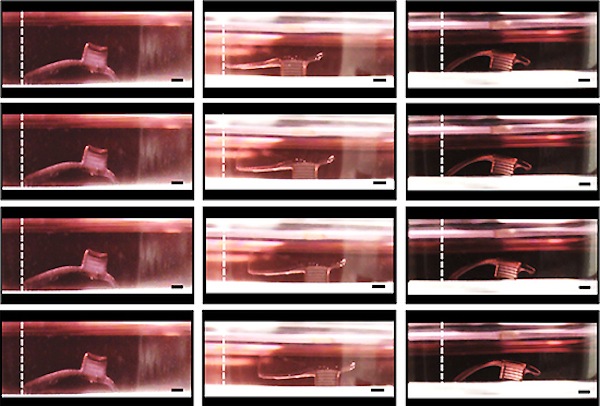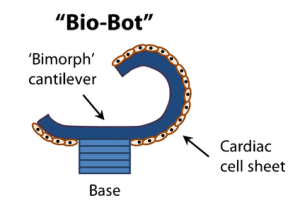Researchers Create Walking Biological Robots Using Heart Cells

A team of scientists at the University of Illinois have built tiny biological robots that walk to the beat of a thin sheet of rat heart cells.
 These "bio-bots," as the team affectionately calls them, are created using a 3D laser printed polymer solution, to which they attach the neonatal rat heart cells and hydrogels. These spontaneously contracting cells pump the robot's "actuator leg," pushing it forward through the liquid, similar to a skateboard, but miniature sized at 7mm long. The top speed has been clocked at 236 micrometers per second, which is about twice the width of an average human hair or 1mm every 4 seconds.
These "bio-bots," as the team affectionately calls them, are created using a 3D laser printed polymer solution, to which they attach the neonatal rat heart cells and hydrogels. These spontaneously contracting cells pump the robot's "actuator leg," pushing it forward through the liquid, similar to a skateboard, but miniature sized at 7mm long. The top speed has been clocked at 236 micrometers per second, which is about twice the width of an average human hair or 1mm every 4 seconds.
Models inspired by mechanical structures found in nature, these bots were created "with desired geometry, mechanics, and cell adhesion molecules for optimal and robust locomotion."
One of the future-gazing practical uses for the bio-bots is in tracking down chemical toxins and releasing a neutralising agent. Of course this is far down the road, and those worrying about being overrun by meat-bots can beathe a sigh of relief. The cells can only contract optimally for roughly 3-5 days, meaning that you're pretty much safe...for now. But on a serious note, this technology can bring transformation to key areas such as developing artificial immune systems, drug delivery, environmental remediation and energy production.
Source: Nature.com (Research Paper)

